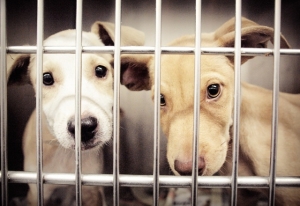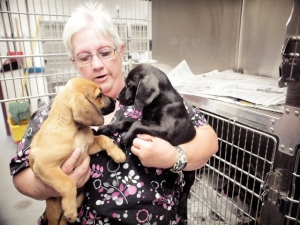Too many to save
By Ty Johnson
Published in News on October 10, 2011 1:46 PM

News-Argus/MICHAEL K. DAKOTA
Two puppies sit in their kennel at the Wayne County Animal Adoption and Education Center. Economic woes have led to an increase in recent years of owner surrenders at the center, with as many as 70 animals coming in a day.

News-Argus/MICHAEL K. DAKOTA
Amy Garofalo, a volunteer at the Animal Adoption and Education Center, pulls two puppies out of their pen at the shelter. The animal shelter in Goldsboro is dealing with overcrowding issues that have gotten worse in the past two years.
The economy has had a rough impact on individuals across the country, but according to Vicki Falconer, director of the county's animal control services department, it has likewise had a negative impact on the lives of furry, four-legged citizens as well.
"In the last two years, the numbers have jumped tremendously," Mrs. Falconer said, of the center's animal population.
The numbers have been especially high for animals abandoned or surrendered by their owners, either because they can no longer care for them or because they choose not to.
The cliche vision of boxes full of kittens and puppies on the doorstep has become a reality for the Animal Adoption and Education Center, complete with notes asking staff members and volunteers to find the young animals good homes. Kennels and cages pop up many mornings at the center, and one staff member came in to take care of the dogs over Labor Day weekend to find a dog leashed to the front door.
Finding homes for all of the animals that come through the center's doors has proven to be a tall task with the shelter filled nearly to capacity a majority of the time, despite the new facilities, Mrs. Falconer said.
Animal services moved into its 1600 Clingman St. location in August 2008, but then-animal control director Justin Scally was prophetic when he cautioned those excited about the new, larger facility.
"The bigger shelter is not the solution," Scally said in 2008. "We need to hit it at the source."
Today the 163 kennels are scarcely empty, with the shelter taking in as many as 70 animals a day at times. Owner surrenders during the months of May, June and July totaled more than 1,000, with July alone having a total of 552 animals, counting owner surrenders and strays.
Of those 552 dogs and cats, 217 were either transferred or adopted, leaving 335 to be euthanized.
The statistics show the sad truth about the animal shelter, Mrs. Falconer said, as more animals come in than the shelter can hold.
She said the length of stay for animals is based on space, but usually tops out at about two weeks. Aggressive animals that are deemed too dangerous to go back on the street are kept for somewhat shorter periods of time, usually about three to five days.
The shortage of space in the facility, however, isn't what's truly contributing to the less-than-favorable ratio of euthanasias-to-adoptions, Mrs. Falconer says -- it begins and ends with irresponsible pet owners.
The staff at the animal shelter has doubled to work within the larger facility, but without spaying and neutering, the animals multiply far faster than the shelter can take them in.
Compounding the problem further, she says, is the shelter's lack of a veterinarian on staff to perform spaying and neutering surgeries as the animals leave the facility, even though the structure was built with an operating room for just such a staff member.
"The county needs to work together and get a spay and neutering program," she said.
Mrs. Falconer said on top of allowing the county to raise revenue for the shelter, it would help control the pet population in a far more efficient manner. Currently the shelter directs those adopting pets to the Wayne County Humane Society's spay and neuter assistance resources, or area veterinarians and must follow up with the individuals to ensure the surgery is actually performed in a timely manner.
This chasing down of those who adopt takes staff members away from other tasks, but more importantly it allows for irresponsible pet owners to slip through the cracks, either through leaving the area or other ways of dodging communication. Intact males and females continue to reproduce, running up the pet population totals in the area, which continues the cycle of overcrowding at the shelter.
That, Mrs. Falconer said, is where the education component of the center is most important. By going into schools and teaching children skills to become responsible pet owners, she hopes to create a new generation of pet owners who understand the importance of population control.
The next Wayne County Humane Society Spay-Neuter Clinic is scheduled for Saturday, Oct. 15, at the Animal Adoption and Education Center. The clinic is for low and fixed-income families. For more information, visit goldsboro-wchs.org.
